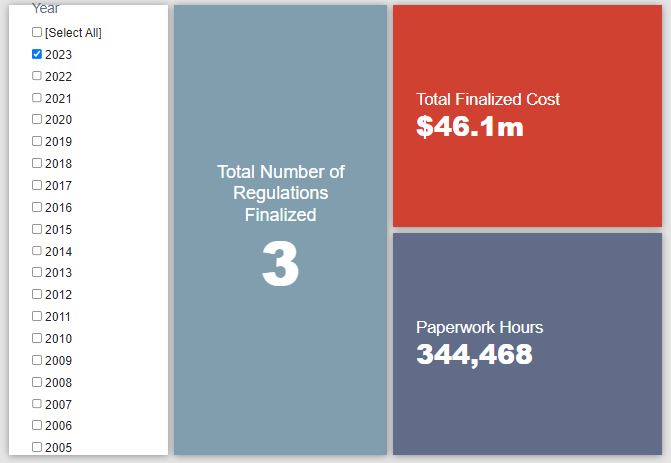Week in Regulation
January 17, 2023
Energy Efficiency Proposals Provide Early January Surge
The new year may only be a couple of weeks old, but agencies are hardly wasting their time. There were 11 rulemakings with some measurable economic impact. More interesting, loyal readers of the “Week in Regulation” series must now go back at least two months to find the last week that did not cross the billion-dollar threshold. This past week’s main fireworks came primarily from a pair of Department of Energy (DOE) proposed rules seeking to update energy efficiency standards for a couple of product classes. Across all rulemakings, agencies published $9.1 billion in total costs and added 383,489 annual paperwork burden hours.
REGULATORY TOPLINES
- Proposed Rules: 48
- Final Rules: 59
- 2023 Total Pages: 2,496
- 2023 Final Rule Costs: $46.1 million
- 2023 Proposed Rule Costs: $13.4 billion
NOTABLE REGULATORY ACTIONS
The most significant actions of the week were two proposed sets of energy efficiency standards from DOE. The relatively large impacts of each are unsurprising given the ubiquity of the products involved. The first seeks to update standards for distribution transformers. In particular, DOE focuses on three categories of transformers: liquid-immersed, low-voltage dry-type, and medium-voltage dry-type. Altogether, DOE expects these standards to increase the total upfront consumer costs of these transformers by nearly $6.2 billion. The second set of efficiency standards focuses on one category of the products to which that distributed energy will eventually flow: “General Service Lamps.” DOE estimates that the total cost increases associated with those proposed standards will add up to roughly $2.4 billion.
TRACKING THE ADMINISTRATIONS
As we have already seen from executive orders and memos, the Biden Administration will surely provide plenty of contrasts with the Trump Administration on the regulatory front. And while there is a general expectation that the current administration will seek to broadly restore Obama-esque regulatory actions, there will also be areas where it charts its own course. Since the AAF RegRodeo data extend back to 2005, it is possible to provide weekly updates on how the top-level trends of President Biden’s regulatory record track with those of his two most recent predecessors. The following table provides the cumulative totals of final rules containing some quantified economic impact from each administration through this point in their respective terms.
![]()
The second week of the new year saw a relative paucity of final rule action continue across all three administrations. A rule from the Department of Agriculture regarding “Pandemic Assistance Programs and Agricultural Disaster Assistance Programs” contributed the bulk of the Biden Administration’s modest bumps in costs and paperwork. There was no movement in any of the Trump Administration’s totals. Meanwhile, a handful of rules from the Obama Administration added up to a mere $15 million in additional costs.
THIS WEEK’S REGULATORY PICTURE
This week, the U.S. Department of Agriculture (USDA) looks to amend its exotic animal regulations.
 Source: Tiger looking the camera by Manuel Alejandro Hung [http://www.geotiempo.com]
Source: Tiger looking the camera by Manuel Alejandro Hung [http://www.geotiempo.com]
On January 9, the Animal and Plant Health Inspection Service (APHIS), an agency within the USDA, published an advanced notice of proposed rulemaking (ANPRM) regarding “Wild and Exotic Animal Handling, Training of Personnel Involved With Public Handling of Wild and Exotic Animals, and Environmental Enrichment for Species.”
APHIS says its aim is to strengthen regulations about how exotic animals are handled for exhibition and how staff are trained to do handling. The ANPRM would also “establish standards addressing environmental enrichment for all regulated animals.”
APHIS envisions setting varying levels of handling and training standards depending on the category of exotic animal involved. It currently intends to propose classifying animals capable of causing severe injury, dismemberment, or death to staff and the public as Category 1. Category 2 animals would be those that could cause serious injury but those not likely to be severe or life threatening. The final category, Category 3, would cover small exotic and domestic animals unlikely to cause serious injury.
The likely proposed rule would also set standards based on whether the public would be engaging in full contact activities, protected contact activities, walk or drive through exhibits, or performances.
APHIS is exploring the expansion of environmental enrichment standards to all covered animals. These standards currently apply only to non-human primates and marine mammals. These standards would likely require licensees to “address the psychological needs of species known to exist in social groups; species-specific feeding, foraging, and food acquisition behaviors; and enclosure space, lighting, and design that allow for species-typical behaviors.” Licensees would have to develop and maintain a written plan for providing environmental enrichment for its animals.
The comment period for the ANPRM is open through March 10.
TOTAL BURDENS
Since January 1, the federal government has published $13.4 billion in total net costs (with $46.1 million in new costs from finalized rules) and 3.1 million hours of net annual paperwork burden increases (with 344,468 hours in increases from final rules).












